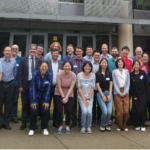Satellite and Earth System Studies
The Satellite and Earth Systems Studies (SESS) Programs main objective is to:
- Enhance our understanding of how the natural components of the Earth system—atmosphere, ocean, land, and biosphere—interact with human activities as a coupled system.
- Collaborative and transformative research activities to enhance NOAA’s and the greater scientific community’s ability to use observations and models to meet that challenge, advance NOAA’s science mission, and identify emerging science needs.
The Satellite and Earth System Studies (SESS) program at George Mason University forms a pivotal research and education branch of Mason’s Earth Science where our grand scientific challenge is to enhance our understanding of how the natural components of the Earth system—atmosphere, ocean, land, and biosphere—interact with human activities as a coupled system.

life (M. Ruzek 1999).

Research
View all of our research:
Publications
View all published works over the years from our dedicated research teams.
View Publications:
Education
View all our information about program details and upcoming course information taught by our faculty.
View all Information:
- Upcoming Conference Presentation on: Recent development of NOAA next generation forecast model via machine learning based on UFS-AQMBeiming Tang will be attending and presenting at two conferences on recent updates and devlopements of NOAA next generation forecast model via machine learning based […]
- George Mason University Scientist Contributes to the latest WMO Air Quality and Climate BulletinGeorge Mason University scientist Dr. Patrick Campbell (GMU/SESS), along with co-authors from the U.S. EPA (Drs. John Waker and Jeremy Schroeder) and NOAA-ARL (Dr. Rick […]
- Greater D.C. Area Atmospheric Composition and Modeling Workshop
 Drs. Patrick Campbell, Daniel Tong, and Youhua Tang of George Mason University’s Satellite and Earth System Studies program hosted the inaugural Greater D.C. Area Atmospheric […]
Drs. Patrick Campbell, Daniel Tong, and Youhua Tang of George Mason University’s Satellite and Earth System Studies program hosted the inaugural Greater D.C. Area Atmospheric […]
